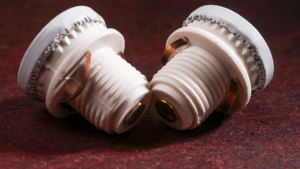
Safety Precautions
When working around electricity, safety is always top priority. After a fuse goes out, your first response should be to unplug all the appliances in the impacted area. Fuses blow because their circuits are drawing more electricity than they were built to handle. Replacing one without reducing power demands will cause it to blow again.
Before opening the fuse box, change into rubber soled shoes and make sure your hands are dry. Water conducts electricity, while rubber is an insulator. Drying your hands minimizes the risk of accidents, while rubber shoes prevent you from being grounded if one occurs. Similarly, rubber gloves and rubber-grip tools are also a good idea. Some homeowners even stand on a rubber mat, for extra protection.
Replacing a Blown Fuse
Once you have finished the necessary safety precautions, go to your fuse box. They’re normally installed in the garage, basement, or utility room. In small homes and apartments, they might be in the main hallway or closet. After you’ve found it, the process for replacing a fuse is simple and straightforward.
- Shut Off the Power. Whenever you’re working with wires or electrical equipment, always shut off the power first. You’ll normally find the main power switch at the top of the fuse box.
- Locate the Blown Fuse. Because the wires combust when the fuse blows, the easiest way to identify a blown fuse is to search for one with blackened glass. Fuses should also be labeled, allowing you to immediately determine which one is connected to which part of the house. If you can’t tell which fuse has blown, you’ll have to remove one and restore power to the electrical panel, repeating the process until you pinpoint the problem.
- Install the New Fuse. Some fuses snap into place while others are screwed. Regardless, after you’ve removed the dead fuse, put a fresh one in its place. Fuses come in different sizes with different ratings, so make sure the new fuse matches the old one. Installing the wrong fuse can cause a short circuit or fire.
After installing the new fuse, flip the main power switch and plug your appliances back in one at a time. With luck, you’ll be able to run them all without any difficulty. If the fuse blows again, it means you’ve overloaded the circuit and some of your devices will have to be moved to another room. However, if your fuses blow repeatedly, it may indicate a more serious problem, such as a short circuit, grounded circuit, or arc fault. You’ll need to call an electrician to investigate.
Be Prepared
Repairing a blown fuse shouldn’t take long. Save time by following these tips, so, when the time comes, you’ll be ready to swing into action.
- Locate Your Fuse Box. Surprisingly, some homeowners never bother to learn the location of their fuse box. Make sure you know exactly where yours is and establish a clear path to it.
- Buy Spare Fuses. Fuses are cheap and available at most hardware stores. Instead of waiting for an emergency, buy some now and store them near your fuse box. Most fuses have a shelf life of around ten years, after which they’re likely to fail if put into use.
- Keep Your Tools and Flashlight Handy. Store supplies someplace convenient. When the power goes out, you’ll want to get to them quickly. If you can’t extract the fuse by hand, a small wrench or needle nose pliers will help get it out. Since there is a good chance you’ll be working in the dark at least part of the time, always keep a flashlight in your toolbox.
- Label Each Fuse. Every homeowner should know which room each fuse is connected to. It’s not only useful when replacing fuses. You’ll need to know how to shut off power before any electrical work can be done on your home.
Fuses are generally found in homes constructed before 1955. Afterwards, quick-open circuit breakers gradually became the preferred safety feature in all new homes across the United States.
Save on Electrical Repairs with Agway
Like every other part of your home, internal wiring doesn’t last forever. Moisture, electrical loads, and extreme temperatures gradually wear them down. They’re even susceptible to damage from insects and rodents. Home insurance doesn’t cover this type of harm, but Agway’s EnergyGuardTM program does.
EnergyGuardTM protects your heating, cooling, and electrical systems* from wear and tear. When the need for repair occurs, our customers don’t waste time hunting around for a qualified repairman. They call us instead. We maintain an extensive network of skilled contractors in your area, so help is never far away. Once we receive your message, we send the first available technician straight to your home. There are no service fees or deductibles either. We pay for the visit and all covered parts. Reach out and start enjoying the benefits of EnergyGuardTM today!
*Coverage depends on commodity purchased.